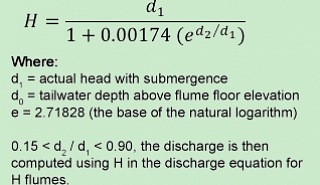When comparing Cutthroat and Parshall flumes, much is made of the Cutthroat flume’s greater resistance to submergence….but is that really true?
The Basics: What is Submergence in a Flume?
When we talk about submergence in a flume we are talking about the amount of resistance in the downstream channel to the free flow of water out of a flume. As the resistance increases, above a certain point the velocity of the water through the flume is reduced, ultimately to a point where the free-flow equation no longer accurately represents what is occurring in the flume. This transition from free, unrestricted flow to slower, backwater flows is known as the submergence transition (St). For flows above the submergence transition, corrections to the free-flow discharge equation have to be made or the free-flow equation will over indicate the amount of flow through the flume.
Parshall Flume Submergence Transitions
The submergence transition for Parshall flumes increases as the flume size increases. Per ASTM D1941, the submergence transition values for Parshall flumes are:
|
1-3 inch Parshall |
50% |
|
6 inch Parshall |
60% |
|
1-8 foot Parshall |
70% |
|
10-50 foot Parshall |
80% |
Cutthroat Flume Submergence Transitions
Like the Parshall flume, the submergence transition for Cutthroat flumes increases as the flumes get bigger – but by the length of the flume (with flumes of different widths but identical lengths having the same submergence transitions).
|
18-inch L Rectangular Cutthroat |
60% |
|
36-inch L Rectangular Cutthroat |
65% |
|
54-inch L Rectangular Cutthroat |
70% |
|
108-inch L Rectangular Cutthroat |
80% |
Conclusions
From the tables above, we can see that for smaller sizes, Cutthroat flumes have submergence transitions 10% higher than similarly sized Parshall flumes. This submergence transition spread continues to the 108-inch length Cutthroat flumes (which general equate to Parshall flumes with throat widths from 1-8 feet). It is only when Parshall flume sizes reach 10-feet or more - sizes for which there is no comparable Cutthroat flume - that the Parshall flume's submergence transition matches that of the largest Cutthroat flume.





